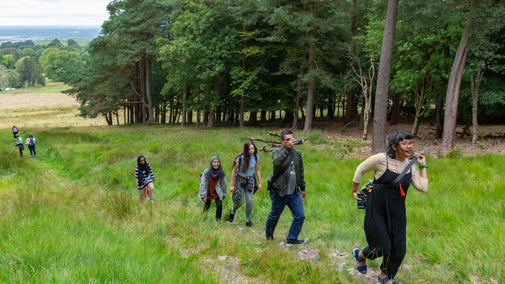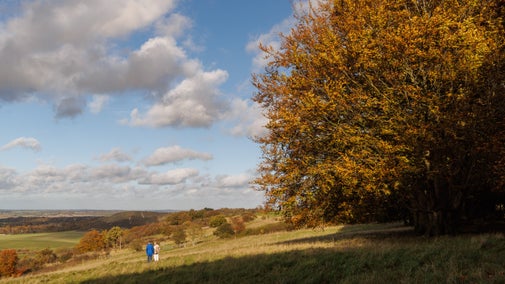Takeley to Wall Wood circular walk
Essex, Bedfordshire & Hertfordshire
This 9.5-mile (15.3km) walk in Essex starts from the disused railway station at Takeley and continues cross-country to the ancient Wall Wood, before returning to Takeley. Along the way, look out for St John the Evangelist Church, Woodside Green, Stane Street Halt and the renowned Doodle Oak.
Near to
Hatfield ForestStart point
Old Station House, Takeley. Grid ref: TL562211Trail information
*There are a number of obstacles on this trail. For further details, please see Terrain section.
**This trail is not suitable for people with reduced mobility. For further details, please see section marked Access.
***Dogs are welcome, with some conditions. For further details, please see section marked Facilities.
More near here
Hatfield Forest and Flitch Way walk
Enjoy the splendour of a medieval hunting forest, passing through ancient trees on the Hatfield Forest and Flitch Way walk.

Hatfield Forest walk
An easy 1.7-mile circular walk through the ancient woodlands at Hatfield Forest, a Site of Special Scientific Interest and National Nature Reserve.

Danbury Common to Lingwood Common walk
An easy, 1.5 mile walk through wetlands, wooded glades and open heathland, that makes an ideal family walk.

Lingwood Common to Blakes Wood walk
A 3.5-mile circular walk, ideal for families, through mixed woodland between Blake's Wood and Lingwood Common.

Get in touch
Bush End Road, Takeley, Bishop's Stortford, Essex, CM22 6NE
Our partners

We’ve partnered with Cotswold Outdoor to help everyone make the most of their time outdoors in the places we care for.
You might also be interested in
Outdoor activities at Hatfield Forest
Discover a range of outdoor activities at Hatfield Forest in Essex. From short to long walks, running routes, horse riding and fishing, there's something for everyone.

History of Hatfield Forest
Find out about some of Hatfield Forest's rich and varied history, including how the original royal hunting forest was created and then, later, how Lancelot 'Capability' Brown left his mark.

Visiting Hatfield Forest with your dog
Hatfield Forest is a two pawprint rated place. It's a perfect place for walking your dog, with 1,000 acres of woodland and open grassland to explore, trees to sniff and grass to roll around in. Professional dog walkers will need a National Trust license to walk a maximum of 4 dogs, up to three times a day.

Deer at Hatfield Forest
Hatfield Forest is home to an established population of both fallow and muntjac deer. Visit the coppices to see how many you can find.

Walking
Explore some of the finest landscapes in our care on coastal paths, accessible trails, woodland walks and everything in between. Find the best places to walk near you.

Walking in Essex, Bedfordshire and Hertfordshire
From long forest wanders to a gentle amble to a famous literary hut, these are some of the best walks around Essex, Bedfordshire and Hertfordshire.

Cotswold Outdoor: our exclusive walking partner
Learn about the National Trust’s ongoing partnership with Cotswold Outdoor. Find out how they help us care for precious places and the exclusive discount available for National Trust supporters.

Staying safe at National Trust places
The special places in National Trust care sometimes come with a few risks for visitors, be it coastline or countryside. Find out how to keep safe throughout your visits.



